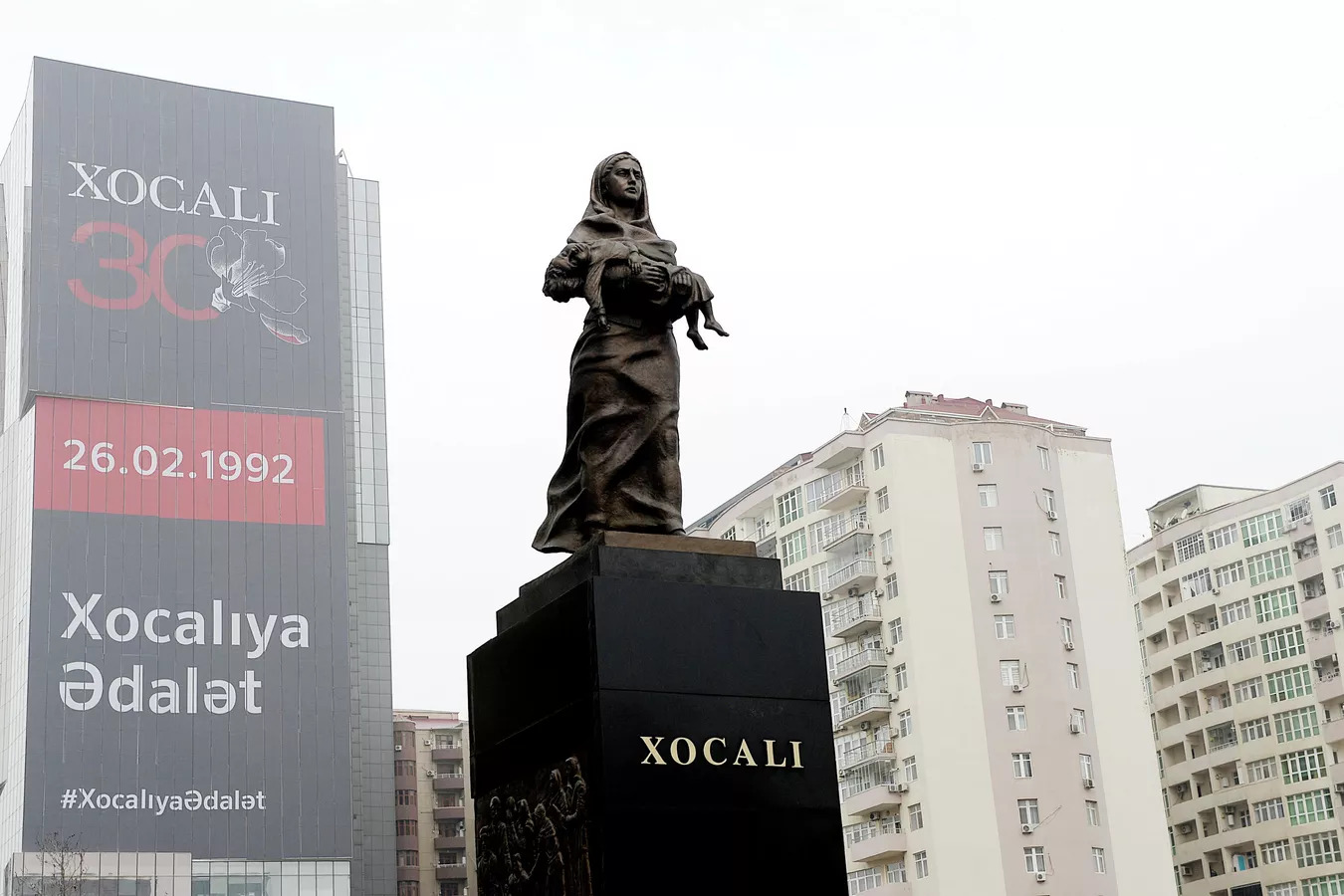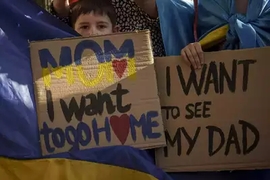Today, Azerbaijanis throughout the world pay homage to victims of the Khojaly genocide, the bloodiest chapter of Armenian terror against Azerbaijanis in recent history.
Azerbaijan’s capital of Baku has become an epicenter of remembrance events, with hundreds of people marching across central streets and gathering at a bronze sculpture that depicts a woman with a dead child in her arms – symbolizing the fate of unarmed civilians that were brutally killed at cold winter night from February 25 to 26 in 1992.
President Ilham Aliyev laid on Monday the cornerstone for the Khojaly Genocide Memorial Complex in Khojaly, a poignant tribute to the lives lost in 1992.
The massacre in Khojaly has been committed within a broader military campaign by Armenia to seize the Karabakh (Garabagh) region, which is an internationally recognized part of Azerbaijan.
The Armenia-Azerbaijan conflict emerged with the anti-Azerbaijan sentiments in Armenia and later grew into armed intervention in Azerbaijan’s internationally recognized territories. A bloody war between the two neighboring countries ended with a ceasefire in 1994 and saw Armenia occupying 20 percent of Azerbaijan’s sovereign territory. Over 30,000 Azerbaijanis were killed and one million were expelled from those lands in a brutal ethnic cleansing policy conducted by Armenia.
The Khojaly genocide is considered one of the bloodiest massacres committed by Armenia against ethnic Azerbaijanis. Late into the night on February 25, Armenia’s forces, backed by the Infantry Guard Regiment No. 366 from a then-collapsed Soviet army, assaulted the town of Khojaly, located in the Karabakh region of Azerbaijan. As a result of the attack, the Armenian armed forces killed 613 ethnic Azerbaijanis, including 106 women, 63 children, and 70 elderly people; and took another 1,275 as hostages. Another 150 Azerbaijani nationals went missing, and their fates remain unknown to this day. Those suffering major injuries or having been maimed totaled 487, including 76 children.
Khojaly residents trying to escape the military invasion were ambushed by Armenian forces and killed, tortured, or tied and abandoned to death in the middle of frosty fields.
“That night I lost my family - my wife and three young children … I couldn't find my family … Till today there is no news from my wife and children. My son was 7 years old, one of my daughters was 13 years old, the other was 11 years old... “ Khojaly Genocide survivor Garyaghdi Guliyev recalls the massacre in Khojaly.
Sixteen countries from around the world including the Czech Republic, Romania, Slovenia, Bosnia and Herzegovina, Mexico, Colombia, Peru, Panama, Pakistan, Jordan, Indonesia, the Scottish parliament in the UK, the 57-country Organization of Islamic Cooperation, as well as 24 state governments in the United States, have officially recognized the events in Khojaly as genocide of Azerbaijanis.
In 2020, Azerbaijani army liberated over 300 settlements, including nine villages of the Khojaly district during the 44-day-long counter-attack operations in the Karabakh region. The war ended in a tripartite ceasefire statement signed by Armenia, Azerbaijan, and Russia on November 10, 2020. Armenia returned the occupied Aghdam, Kalbajar, and Lachin districts to Azerbaijan as part of the agreement.
Mass graves in Khojaly
In a significant development following the Azerbaijani Army's one-day local counter-terrorism operations in September 2023, which resulted in the liberation of Khojaly from the Armenian armed separatist control, Azerbaijani authorities have been able to conduct thorough searches for individuals missing since the First Karabakh War (1991-1994). This effort led to the discovery of several mass graves in the area, with the most recent one found on February 21.
The Prosecutor General’s Office of Azerbaijan, through procedural actions, has determined that the skeletal remains in the mass grave are of at least four individuals. Among them is presumed to be a child aged around 4-5 years, along with women. Indications are that these individuals were subjected to torture and subsequently bound with ropes before being buried.
A particularly poignant discovery was made on February 11 near the Asgaran fortress in Khojaly, where a mass grave believed to contain the remains of victims from the 1992 Khojaly Genocide was unearthed. This revelation came to light following the interrogation of Rashid Beglaryan, identified as one of the perpetrators of the Khojaly massacre. Preliminary analyses suggest that the remains are of at least eight individuals, likely fallen during the tragic events of 1992.
Thomas de Waal, a Senior Fellow at Carnegie Europe, references an interview with Armenia’s former President Serzh Sargsyan in his book "Black Garden." Sargsyan, who led Armenian separatist forces during the 1990s Karabakh war, did not deny the involvement of Armenian forces in the killing of Azerbaijani civilians during the Khojaly events. In a candid admission, Sargsyan remarked that the massacre was a turning point, intended to shatter the Azerbaijani perception of Armenians as incapable of violence against civilians, suggesting that the killings served as an act of deliberate mass intimidation.
The government of Azerbaijan has been restoring Khojaly following its liberation last year. Moreover, Khojaly has reached a historic milestone by conducting its first elections in three decades, a significant sign of the city's journey towards restoration and normalization after years of conflict. The elections on February 7, observed internationally and covered extensively by the media, saw active participation of Khojaly's residents highlighting a new chapter of hope and resilience for the city.







 Azerbaijan and Armenia started the process of demarcation of their border on Tuesday, with the installation of the first border markers based on ge...
Azerbaijan and Armenia started the process of demarcation of their border on Tuesday, with the installation of the first border markers based on ge...
 Armenian sappers commenced on Monday mine-clearance operations in the territories adjacent to the Saint Mary Church in village of Voskepar (Armenia...
Armenian sappers commenced on Monday mine-clearance operations in the territories adjacent to the Saint Mary Church in village of Voskepar (Armenia...
 Iran and Pakistan have signed eight cooperation documents in various fields, and agreed to strengthen ties to fight terrorism in the region.
Iran and Pakistan have signed eight cooperation documents in various fields, and agreed to strengthen ties to fight terrorism in the region.
 President Aliyev emphasized the critical role of the North-South Transport Corridor in fostering transport cooperation between Azerbaijan and Russi...
President Aliyev emphasized the critical role of the North-South Transport Corridor in fostering transport cooperation between Azerbaijan and Russi...



